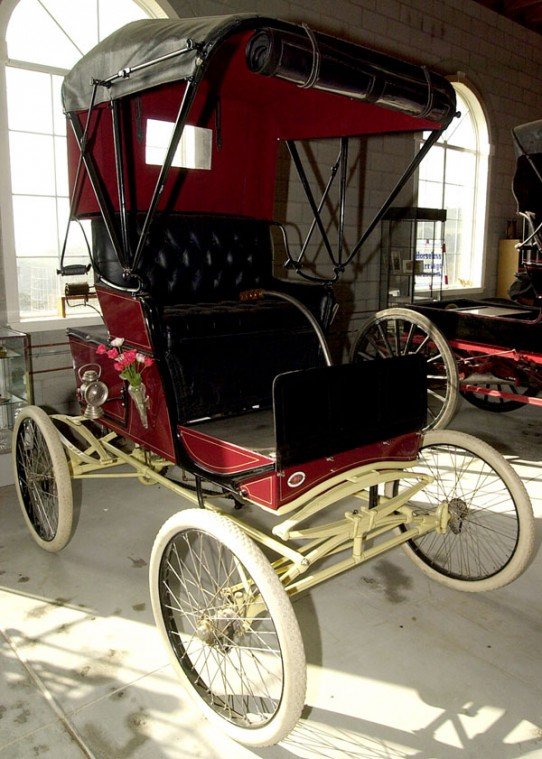GILROY
– In a building up in the hills northeast of Gilroy on twisting
Roop Road is a place where some of the oldest cars in America go to
get a new start.
GILROY – In a building up in the hills northeast of Gilroy on twisting Roop Road is a place where some of the oldest cars in America go to get a new start.
These cars find their way into Eric Anninger’s car collection in varying condition, but they are all finding their way back to their glory days.
“Most of these are from what is know as the ‘Horseless Carriage’ era,” Anninger said. “A few of these are the last-known survivors.”
The Horseless Carriage era, Anninger said, is usually described as cars build before 1916 and are known for their cranking engines and brass parts.
“This is called the brass era,” he said.
Some of the cars also were built kerosene lamps for headlights that the driver would have to go out and light. The cars all start and drive so differently that even Anninger has to become reacquainted with it before taking it out on the road – yes, these cars do run.
“When I drive a different car, I have to get familiarized with it,” he said. “All of these cars run except for one – they’re all actual runners.”
Anninger has cars from 20 different manufacturers, including REO, Packard, Excelsior, Cadillac, Maxwell, Jackson, Ford, Moline, Overland and Buick in his museum – or what will be his museum.
“It’s going to be a museum when I’m done,” he said. “But now it’s a garage.”
Anninger has a plan for the his museum, including setting up scenes of an old gas station and a fire house.
“It’s going to be like a themed museum with different scenes,” he said. “But it’s going to be a while. I’ve only been up here two years.”
Anninger often is visited by auto clubs, but he hopes to make his museum into a place where others can come and get a new understanding of the history behind the automobile.
“I want to be able to bring school kids up here,” he said. “A lot of them don’t even know there were cars that had to be cranked.”
Meanwhile, the cars, ranging in value from $20,000 to $100,000, quietly sit in Anninger’s garage – one of them a green 1913 Lozier Model 72 Riverside, the fastest car in Anninger’s collection. The 5,800-pound car, which seated as many as seven, could do more than 70 mph with its six-cylinder engine.
“This was one of the biggest cars of the era,” Anninger said.
Surprisingly, the old crankers have more amenities than most would imagine. Some of the cars had tilt steering, gas/electric engines, and one even was designed for a woman driver in the back seat so she could talk with friends (the front seats faced in toward the back).
“It’s the same stuff over again,” Anninger said of what he sees in cars today with gas/electric hybrids and luxury features. “This isn’t anything new.”
Anninger’s oldest car is a 1899 Marlboro Steam Car. The vehicle runs on a steam engine and its two-cylinder engine had a whopping six horsepower.
Anninger began work on his museum after he sold his Morgan Hill sheet metal company, BAS, five years ago.
“It became too much of a hassle so I sold it,” he said.
Now Anninger and his father spend their days working on rebuilding cars.
“I just make a job out of it,” he said. “It’s the funnest hobby I’ve got going.
“I’ve always been a gear head,” he said. “Instead of doing hot rods, I got into classic cars. I got my first one and fell in love with it.”
Anninger said finding the cars isn’t any easy feat.
“You just don’t see them in The (San Jose) Mercury for sale,” he said.
And once Anninger gets a car, fixing it up can take a lot of time.
“It’s a long process,” he said. “It depends on the rarity of the parts. Sometimes you have to build them.”
Obviously, you can’t just show up asking for parts for a 1914 Buick at the local parts store, so Anninger has created a workshop where he can build most of the parts he needs. He also has an office in his museum that is full of books to help him figure out how to create a part.
“It’s important when you restore cars that if you want to bring them back to authentic, you have to research,” he said. “They take a lot of care. You have to know your machine to take care of it.”
Anninger also can get parts at specialty auto shows, including one he visits in Pennsylvania.
“I go there with a bucketload of cash and come back with parts to rebuild again,” he said.
But Anninger doesn’t just travel for parts. He also enjoys taking his cars out on the road to horseless carriage conventions.
“There’s nuts and bolts falling down and everyone’s having a good time,” he said. “It’s just a blast.”
Anninger makes about three or four of these trips each year, going as far as Idaho to meet with other antique automobile enthusiasts. He is also a member of the Santa Clara chapter of the National Horseless Carriage Club of America, which hails more than 5,000 members.
“The goal is the preserve the horseless carriage era,” he said. “Preserving these cars – that’s what’s most important.”
For more information about Eric Anninger’s horseless carriage collection visit www.ecollector.com.













